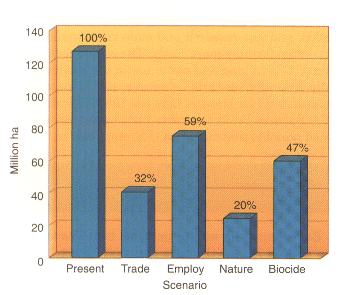European facts and projections buttress those of the United States. In only five years from 1980 to 1985, agricultural production in ten European nations rose about one-twelfth. But Eurostat data show that from 1966-1967 to 1983 the cultivated land in six European nations fell about one-quarter (Nijkamp and Soeteman, 1988[NS88]). The polder begun near Amsterdam remains underwater as an undeveloped witness to agricultural surplus.
While the cultivated area was declining, saving some land for Nature, were the trees in European forests growing? During the past score of years enough has been written about air pollution and the health of European forests to worry the reader. So I mention trees as well as cropland area. Although repeated surveys are available from only a third of European forests, foresters (Kauppi et al., 1992[KMK92]) estimate that the growing stock in Europe grew 30% from 1971 to 1990. ``This information seemingly contradicts the commonly held view of a forest decline. ...A decline of forest resources in Europe is a threat for the future, not a historical fact."
Looking forward, the Dutch
(Rabbinge et al., 1992[R![]() 92])
92])![]() projected to 2015 AD. the changes from the present 130
million ha of farmland in the European Community
(EC) of nations (Figure 10.2.1.). They envisioned four
scenarios that I name according to the preeminent character
of each. The Trade scenario emphasized liberalization
of trade, which would continue encouraging the
growing European importation of oil seeds and grain.
Since 1962, the EC has imposed little restriction on oil
seeds and grain substitutes, mainly for feed, and their
importation has grown. The Dutch project scenario
Trade would cut cropland about two-thirds. Scenario
Employ would spread farm employment equally over
European regions and cut cropland about 40%. Emphasizing
conservation, scenario Nature would lower cropland 80%.
Even scenario Biocide, emphasizing crop
protection with minimum use of pesticides, would allow
cropland to fall by half.
projected to 2015 AD. the changes from the present 130
million ha of farmland in the European Community
(EC) of nations (Figure 10.2.1.). They envisioned four
scenarios that I name according to the preeminent character
of each. The Trade scenario emphasized liberalization
of trade, which would continue encouraging the
growing European importation of oil seeds and grain.
Since 1962, the EC has imposed little restriction on oil
seeds and grain substitutes, mainly for feed, and their
importation has grown. The Dutch project scenario
Trade would cut cropland about two-thirds. Scenario
Employ would spread farm employment equally over
European regions and cut cropland about 40%. Emphasizing
conservation, scenario Nature would lower cropland 80%.
Even scenario Biocide, emphasizing crop
protection with minimum use of pesticides, would allow
cropland to fall by half.
 Figure 10.2.1. Farmland in the European Community at present
and projected for 2015 A.D. for four policies: liberal
Trade policies, maintaining farm Employment,
conserving Nature, and protecting crops with
minimum use of Biocides (Rabbinge et al., 1992). [R
Figure 10.2.1. Farmland in the European Community at present
and projected for 2015 A.D. for four policies: liberal
Trade policies, maintaining farm Employment,
conserving Nature, and protecting crops with
minimum use of Biocides (Rabbinge et al., 1992). [R![]() 92]
92]
By the way, all scenarios, even Employ, would lower farm employment in the EC to less than half the present 6 million. Scenario Trade would lower it most, fully three-quarters. The Dutch visualize that in all scenarios the use of pesticides will decrease drastically.